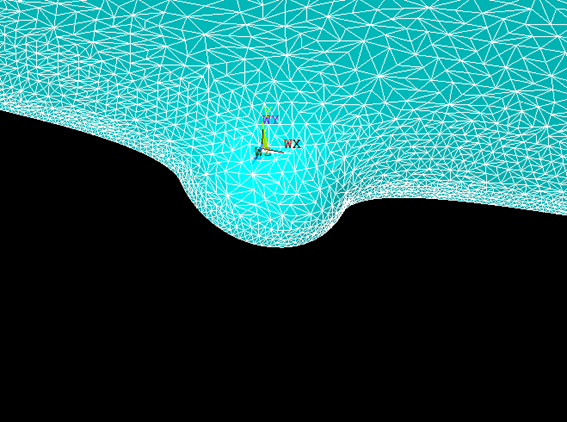-
-
October 27, 2021 at 4:16 pm
Juanjo
SubscriberHello everyone,
I am a good expertise in APDL but not in Workbech, so… since I don’t find a workflow to solve my problem in APDL, perhaps someone can help me.
I have to solve a problem in two steps. In the first step, a metal awl compresses a rubber eraser. This is a structural problem that we have solved without inconvenience: the domains are constructed by volumes, then are meshed, and solved. All is ok.
But now, in the second step, I need to construct a second model, very different to the first one, that uses the upper side of the rubber eraser as a unique deformed AREA to construct the model. This is very important (ONE AREA), because this deformed upper surface will be the interface between two domains, and some boundary conditions will be applied on the area.
I have approach the problem by using the great scripts:
https://simutechgroup.com/export-the-deformed-geometry-shape-from-an-ansys-model/
This script gets the original nodes; updates the geometry using the nodes displacement obtained in the last step; gets the new nodes coordinates; and creates thousands of small areas at those places were an element was before (see figure). Nice, but I need a unique curved area.
Since IGES is one of the formats admitted to import and export files in APDL, I have exported the figure (thousands of small areas, IGES format) and I have also exported only the nodes coordinates (cloud points, TXT format). The idea was to create a curved surface using CAD (SpaceClaim, Cloudcompare, Meshlab, FreeCAD…) and then to export the unmeshed surface in IGES format to be read by ANSYS APDL. But… as you can see, I have no got it after a week working on it.
In summary, the questions are:
1. I need to create in APDL a geometrical model based on an arbitrary curved area which is the result of a previous mechanical problem. The ways we are using to get it are described above, but perhaps there is other easier way. Suggestions?
2. Imagine that we have a cloud points, or thousands of small areas representing the desired surface. How can we obtain, in IGES format, a unique curved area of the curved surface?
Help!
Thanks a lot in advance!
October 28, 2021 at 12:38 pmAniket
Forum Moderatortwo questions:
Do you want this in APDL or Workbench?
Do you need deformed geometry or deformed mesh is ok?
-Aniket
How to access Ansys help links
Guidelines for Posting on Ansys Learning Forum
October 29, 2021 at 8:52 amJuanjo
SubscriberAniket, thanks a lot for your interest!
About your questions:
1. My Comfort Zone is in APDL. But I have not found a way to create an arbitrary folded geometry in APDL. Spline curves and its displacement to create areas do not work since some other types of awl will be used and there is no symmetry. Therefore, I planned to export the results of the structural problem, hopping for finding a method to create an IGES file of the deformed area by using a third party software, and import back to APDL to construct the second model.
2. I need the deformed geometry! The second model that is based on the deformed geometry is very complex, and requires applying several boundary conditions on the deformed geometry. Certainly, I can compile the thousands of small areas that you can see in the figure and, later, apply the boundary conditions on the ÔÇ£componentÔÇØ, but it becomes very slow and that could be the last alternative.
On the other hand, I have found that there is a powerful tool in SpaceClaim, called ÔÇ£reverse engineeringÔÇØ, but it requires a good expertise skill to obtain acceptable results.
Thanks again, Aniket.
Viewing 2 reply threads- The topic ‘About using deformed geometry in new model’ is closed to new replies.
Innovation SpaceTrending discussionsTop Contributors-
4607
-
1515
-
1386
-
1209
-
1021
Top Rated Tags© 2025 Copyright ANSYS, Inc. All rights reserved.
Ansys does not support the usage of unauthorized Ansys software. Please visit www.ansys.com to obtain an official distribution.
-


Ansys Assistant

Welcome to Ansys Assistant!
An AI-based virtual assistant for active Ansys Academic Customers. Please login using your university issued email address.
Hey there, you are quite inquisitive! You have hit your hourly question limit. Please retry after '10' minutes. For questions, please reach out to ansyslearn@ansys.com.
RETRY








